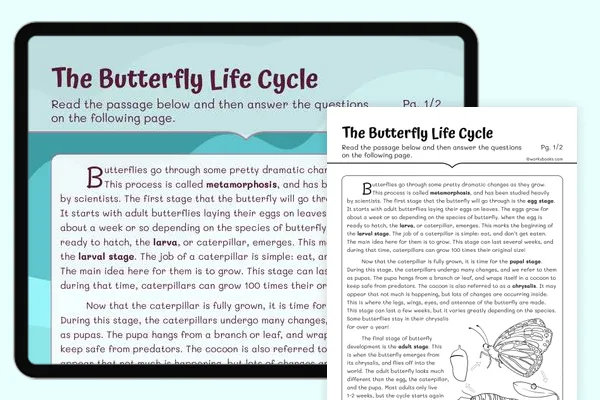Early Life Forms and Their Adaptations — Reading Comprehension
Grades
- 3
- 4
- 5
- 6
Standards
- RI.3.3
- RI.4.3
- RI.5.3
- 3-LS4-2
PRINT+DIGITAL RESOURCE
This learning resource is available in interactive and printable formats. The interactive worksheet can be played online and assigned to students. The Printable PDF version can be downloaded and printed for completion by hand.
About This Reader
This educational passage focuses on early life forms and their basic adaptations, supporting NGSS standard 3-LS4-2 for elementary students. The content explores Earth's ancient oceans from 500 million years ago, introducing students to prehistoric marine ecosystems before land plants and animals evolved. Students learn about trilobites with their protective exoskeletons and specialized compound eyes that helped detect predators. The passage explains various survival adaptations of early sea creatures, including defensive structures, movement capabilities, and sensory advantages. It introduces the concept of extinction when organisms cannot adapt to environmental changes, while explaining how some early vertebrates evolved into modern animals with backbones. The text connects scientific knowledge to fossil evidence, helping students understand how paleontologists learn about ancient life. Throughout the passage, the fundamental concept of adaptations as survival features is reinforced, while the dual themes of diversity (different adaptations for different environments) and unity (connections through evolutionary relationships) are highlighted in age-appropriate language. This foundation helps young learners grasp basic evolutionary concepts that will be built upon in later grades.
Perfect For:
👩🏫 Teachers
- • Reading comprehension practice
- • Auto-graded assessments
- • Literacy skill development
👨👩👧👦 Parents
- • Reading practice at home
- • Comprehension improvement
- • Educational reading time
🏠 Homeschoolers
- • Reading curriculum support
- • Independent reading practice
- • Progress monitoring
Reading Features:
📖
Reading Passage
Engaging fiction or nonfiction text
❓
Comprehension Quiz
Auto-graded questions
📊
Instant Feedback
Immediate results and scoring
📄
Printable Version
Download for offline reading
🔊
Read Aloud
Voice-over with word highlighting





















